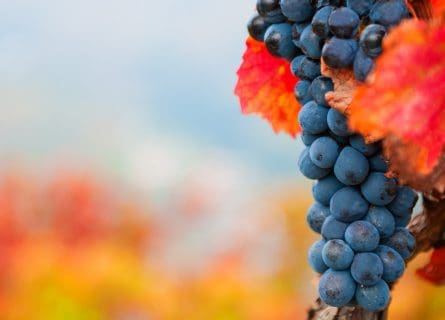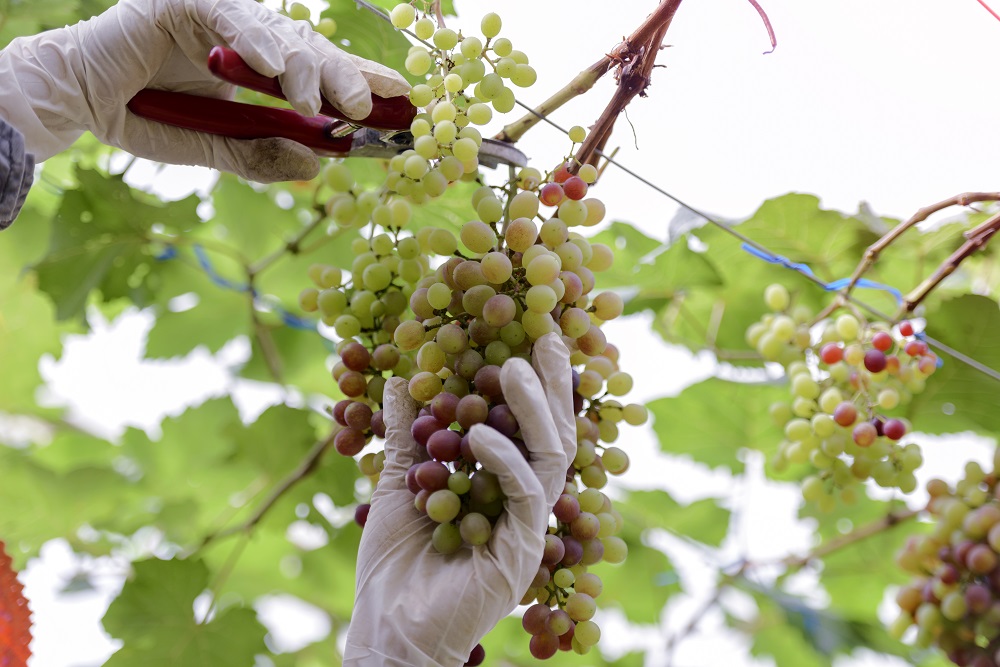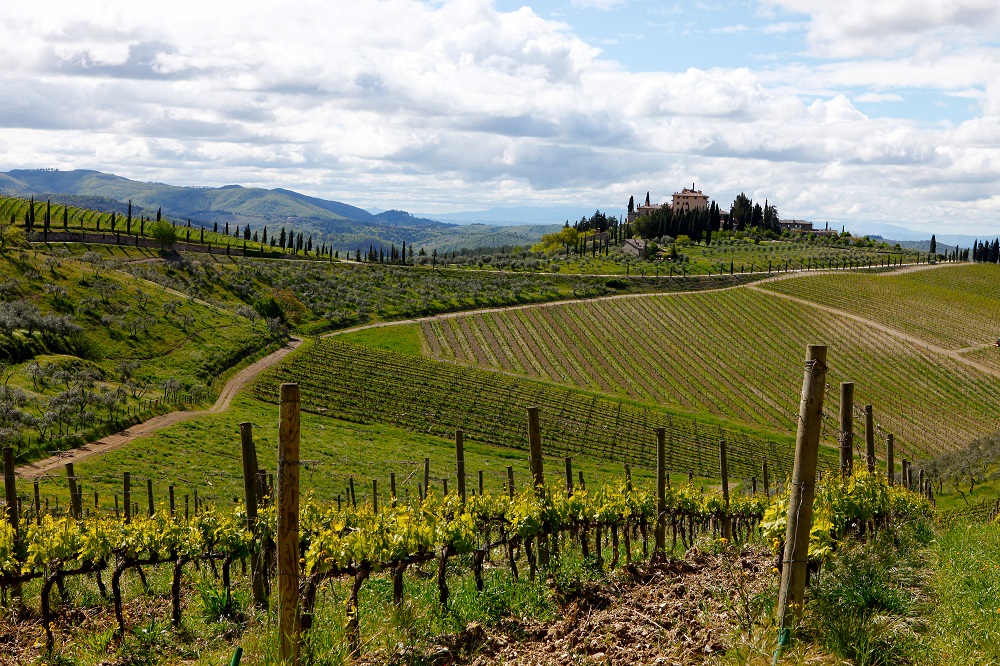
Baga Grape Variety: A Great Revival
May 6, 2022
Baga is a dark-skinned grape varietal grown mainly in the central Portuguese region of Bairrada DOC, producing high acidity tannic wines.
By: James lawrence / Last updated: February 3, 2025
Estimated reading time: 9 minutes
Regular visitors to our blog may have detected a certain sniffiness toward this ubiquitous variety. You might construe this as a simple case of jumping on the bandwagon: wine critic and author Ian D’Agata describes Trebbiano Toscano as one of Europe’s most maligned white grapes. Trebbiano Toscano is everywhere in over 80 DOC appellations, from Abruzzo’s hills to Campania’s volcanic terrain. It is one of the most widely planted grapes in the world. It is Italy’s most common white variety; Glera and Catarratto take second and third place, respectively. Finding a Trebbiano wine is as easy as searching for exquisite pizza in Naples.

Guide to Italian White Wine: Read more
However, the widespread apathy often directed at Trebbiano Toscano is not just about overexposure. For many decades, the grape has been exploited to make terrible wine – the Chianti Classico Consorzio used to encourage growers to blend Trebbiano into their reds due to its high yield and robust nature. Unfortunately, this seldom enhanced the quality of the Sangiovese: overcropped Trebbiano Toscano is “tart mouthwash,” to quote Jancis Robinson MW. But leave it to the Italians to coax beauty and charm out of this ugly duckling. Unfortunately, the success stories are dwarfed by the gallons of rank mediocrity exported worldwide. Nevertheless, the phrase ‘high-quality Trebbiano’ is no longer an oxymoron.
Trebbiano Toscano has been part of the Italian landscape for many centuries. Historians believe that the grape originated in the Eastern Mediterranean – the Greeks introduced several varieties to Italy in the 8th century BC, establishing a legacy of wine growing that has stood the test of time. So too, were the Etruscans’ passionate devotees of the grape. However, the Romans conquered the entire peninsula, which, by the 2nd century BC, had subjugated the other Italian tribes and the remaining Greek colonies around the coast. Rome became the capital of a mighty empire, introducing its cultural practices, laws, and customs to much of Western Europe. This, of course, included the noble art of wine growing. Rome’s leading poet, Pliny, the Elder, referred to one particular variety as ‘Vini tribulanum’ in his writings, which may be the first recorded mention of Trebbiano Toscano.
Other historians, however, believe that the grape took its name from the Trebbia river in Emilia-Romagna. What we know for certain is that the wines of ancient Rome bore little resemblance to what we enjoy today. Adulterated with herbs, sweetened with honey, and often cooked until the wine maderized, it was an unctuous concoction of intense sweetness. The best Roman wines were said to be capable of aging for decades.
However, the Western Roman Empire collapsed in 476 AD – Italy would not embrace a unified government again until the 19th century, incredible as that sounds. The Dark Ages saw little stability as the country fell to Germanic invaders and their kin. Yet the Romans had bequeathed Western Europe its most powerful and influential force to date: Christianity and the Roman Catholic Church. In the 9th century, at the height of the church’s power, the papacy summoned the Carolingian Franks to drive out the bellicose Lombards from Italy, a task at which they excelled!
After several fierce battles, the Frankish king Charlemagne was crowned Holy Roman Emperor in 800 AD, exercising control over a vast dominion that included part of Germany, France, and northern Italy. By the Middle Ages, the church had assumed responsibility for nurturing Europe’s wine industry. Indeed, Italy’s ancient monasteries and cathedrals could be considered the nation’s first wineries; viticulture was a major part of ecclesiastical life during this period.
Meanwhile, a succession of European invaders – Normans, Angevins, and Aragonese – conquered Sicily and much of southern Italy. Even the Medici family of Tuscany could not compete with great powers like the Habsburgs: central Italy fell prey to the Spanish in the 1500s. At the same time, Austria controlled great swathes of the north. This haphazard political arrangement did not end until the 1860s when Victor Emmanuel II of Savoy became the first monarch to preside over a united nation.
During this era, Baron Bettino Ricasoli established the formula for producing Chianti Classico – Trebbiano Toscano was noticeably excluded from the list of “other” recommended varieties in the blend, which included Cabernet Sauvignon and Merlot. However, when the Chianti DOC was subsequently introduced in 1967, Trebbiano was included as an obligatory part of the final blend. In the post-phylloxera environment, growers were understandably keen to maintain varieties that offered a reliable – and generous – yield. Unfortunately, this did nothing to improve the quality of local red wines, which reached a low point in the 1980s. Thankfully, in 1996, the Chianti Classico DOCG was changed to allow 100% Sangiovese wines in the zone.
Nevertheless, Trebbiano has remained a vital part of the Italian viticultural landscape, largely due to its popularity with commercially driven wineries. It ripens late in the season, delivering a substantive crop of large berries. Moreover, Trebbiano is fairly adaptable and can thrive on various soil types. In warm climates, it is astonishingly easy to grow.
The 21st century has witnessed a resurgence of interest in producing high-quality wine from Trebbiano Toscano. Castelli del Grevepesa was one of the first in Tuscany to prove a point: the estate’s Bianco Toscana IGT wine is one of the region’s finest dry whites. Aromatically expressive and very fruity, it offers notes of melon, grapefruit, citrus, and lanolin on the mid-palate; even a seasoned critic would scarcely recognize the wine as Trebbiano! Yet it is the genuine article, blended with a percentage of Chardonnay to add weight and structure. This minor ‘miracle’ was achieved by drastically cutting yields and investing in higher-quality clones of the Trebbiano grape. And last but not least, utilizing the best of modern winemaking equipment.

The white is made by adopting a widely used formula in Alsace: protective winemaking; this involves extracting every ounce of flavor and aroma from the grape’s juice via a cool fermentation in stainless steel tanks. Castelli del Grevepesa only uses hand-harvested grapes in their wines, chilling the must before it is transferred to a pneumatic press. This vinification stage is crucial – the winemaker will want to extract only the purest, free-run juice from the berries, avoiding any phenolic pickup. This crystal clear must is then vinified in stainless steel, after which malolactic fermentation will occur. What emerges in bottle is a superior interpretation of Trebbiano Toscano – fruit-driven and very fresh. It competes in the marketplace with the delicious whites of Pecorino, Greco, and Piedmont’s Cortese grape.
Trebbiano Toscano is also used to make delicious Vin Santo wines. It relies on a very traditional technique known as passito – the ancient Greeks pioneered this process, whereby grapes are left to dry out on straw mats in the sun. Over the months, the berries will lose much of their water content, concentrating the sugars and desiccating the skins. The sugar-rich must is then extracted and fermented in various vessels, including oak, concrete, and stainless steel. Due to the high volume of sucrose, the yeast will often become ‘exhausted’ before all the sugar has been converted to alcohol; sulfur can also be used to kill off the remaining yeast cells. The best labels are then aged for several years in wood, gently oxidizing the wine and imbuing a rich, nutty complexity.
Fifteen years ago, the idea of an expensive white wine based on Trebbiano Toscano would have been met with deafening snorts of derision. And yet, Petrolo’s Boggina B Trebbiano cuvée sells for more than $60 a bottle. Complex, balanced, and seductively scented, Petrolo represents the complete antithesis of high-yield Trebbiano. Most importantly, Petrolo has inspired other growers to follow its lead.
The estate is one of Tuscany’s most iconic wine producers, having cultivated vineyards since the 18th century. However, its modern reputation was established by the Bazzocchi family, who purchased the land in the 1940s. Situated on the border of the Chianti Classico zone, these organically farmed vineyards benefit from a high elevation of 450 meters above sea level. This privileged position is one of the reasons why Petrolo’s signature white is incredibly fresh, even during torrid vintages like 2018. But, although the vines were first planted in the 1970s, Petrolo did not commercialize the white until 2014.
The family wanted to wait until they could market a label worthy of their international reputation – an expression of Trebbiano Toscano that would set a new benchmark for quality. The winemaking, meanwhile, is first-rate; Petrolo had the wisdom to hire Mounir Saouma of Lucien Le Moine in Burgundy. Under his direction, low-yielding vines are manually harvested, while the winery’s sorting table discards all but the healthiest fruit. Fermentation then takes place in wooden casks using wild yeast. The wine is aged on its fine lees for over 15 months, with regular lees stirring during the initial three months. It is then bottled, ready for you to enjoy without further racking.
We first came across this remarkable wine in 2019. Tasted blind, you’d swear you were drinking Hermitage Blanc or perhaps a particularly exotic interpretation of Fiano. The nose is exquisite: a heady whirlwind of orange blossom, macadamia, honeysuckle, apricot, and lime. Meanwhile, the palate is rich and opulent, with textbook acidity balancing out the inevitable concentration resulting from such low yields. Critics and buyers have described Boggina B as “a bit of Burgundy with a Tuscan twist.” Yet this moniker is somewhat misleading. This beautiful wine is wholly and proudly Italian. It symbolized a country’s refusal to give up on a variety that many regarded as the apex of mediocrity. It represents the future of luxury Italian white wine.
If you would like us to customize an exclusive luxury tour, contact us and let us know your travel plans. We offer luxury food and wine tours for private groups of a mininium two guests. In addition, all of our private, chauffeured tours are available year-round upon request.

